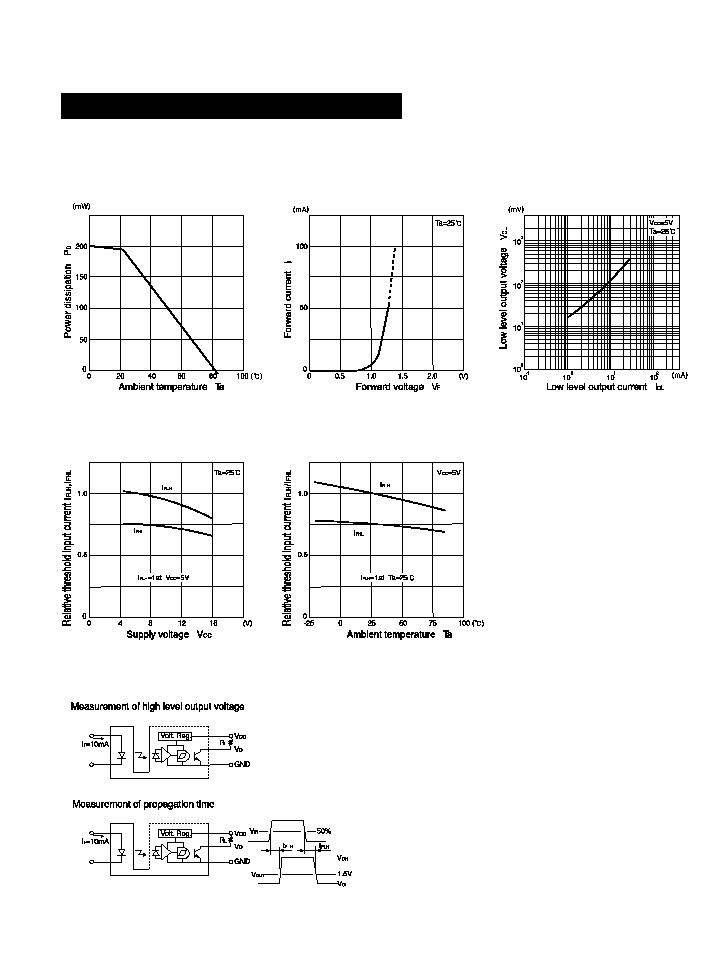
- 1-
L G - 2 0 7
Photointerrupters(Transmissive)
K O D E N S H I
Forward voltage
Reverse current
C a p a c i t a n c e
Operating supply voltage range
Low level output voltage
High level output voltage
* 2
Low level supply current
High level supply current
L H threshold input current
H y s t e r e s i s
L H propagation time
* 3
H L propagation time
* 3
I n p u t
O u t p u t
T r a n s m -
i s s i o n
The LG-207 photointerrupter combine high output
GaAs IRED with photo IC.
The sensor makes possible easy development of
objectdetecting systems with high performance, high
reliability and small equipment size.
F E A T U R E S
∑Compatible to TTL and LSTTL
∑Built in Amplifier and Schumitt Trigger
∑Wide Vcc range
A P P L I C A T I O N S
∑Floppy disk drives
∑C o p i e r s
∑F a c s i m i l e s
∑Paper sensors
D I M E N S I O N S
(Unit : mm)
( T a = 2 5)
ELECTRO-OPTICAL CHARACTERISTICS
I
F
= 6 0 m A
V
R
= 5 V
V=0V, f=1MHz
I
O L
= 1 6 m A , V
C C
= 5 V , I
F
= 0
I
F
= 1 0 m A ,V
C C
= 5 V ,R
L
= 1 0 K
V
C C
=5V, I
F
= 0
V
C C
=5V, I
F
= 1 0 m A
V
C C
= 5 V
V
C C
= 5 V
V
C C
=5V, I
F
= 1 0 m A
R
L
= 2 8 0
I t e m
T y p .
1 . 3
2 5
2
2
6
0 . 7 5
2
1
V
F
I
R
C
t
V
C C
V
O L
V
O H
I
C C L
I
C C H
I
F L H
I
F H L
/ I
F L H
t
P L H
t
P H L
4 . 5
4
1 . 6
1 0
1 6
0 . 4
7
7
V
A
p F
V
V
V
m A
m A
m A
-
s e c .
S y m b o l
C o n d i t i o n s
M i n .
M a x .
U n i t .
R a t i n g
S y m b o l
I t e m
MAXIMUM RATINGS
P
D
V
R
I
F
V
C C
I
O L
P
T o p r .
T s t g .
T s o l .
1 0 0
5
6 0
1 6
3 0
2 0 0
- 2 0 ~ + 8 5
- 3 0 ~ + 8 5
2 4 0
m W
V
m A
V
m A
m W
U n i t
( T a = 2 5)
*1. For MAX. 5 seconds at the position of 1mm from the package
Power dissipation
Reverse voltage
Forward current
Supply voltage
Low level output current
Power dissipation
Operating temp.
Storage temp.
Soldering temp.
* 1
I n p u t
O u t p u t
*2,*3. refer to measurement diagram as right side.

- 2-
L G - 2 0 7
Photointerrupters(Transmissive)
Power dissipation Vs.
Ambient temperature
Forward current Vs.
Forward voltage
Low level output voltage Vs.
Low level output current
Relative threshold input current Vs.
Supply voltage
Relative threshold input current Vs.
Ambient temperature

